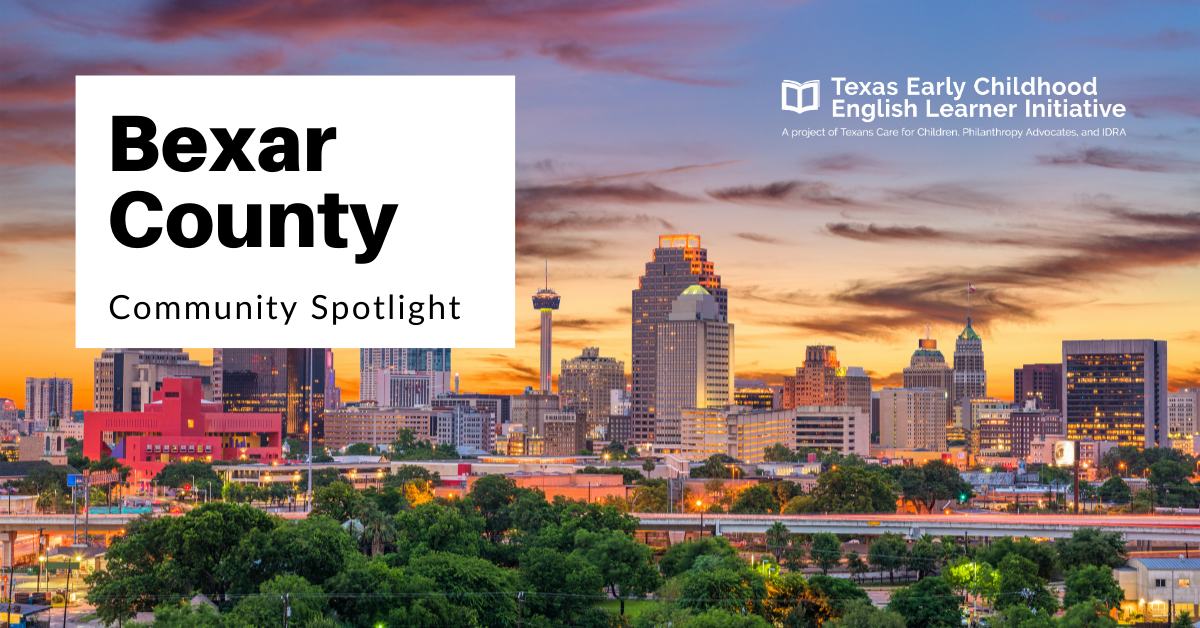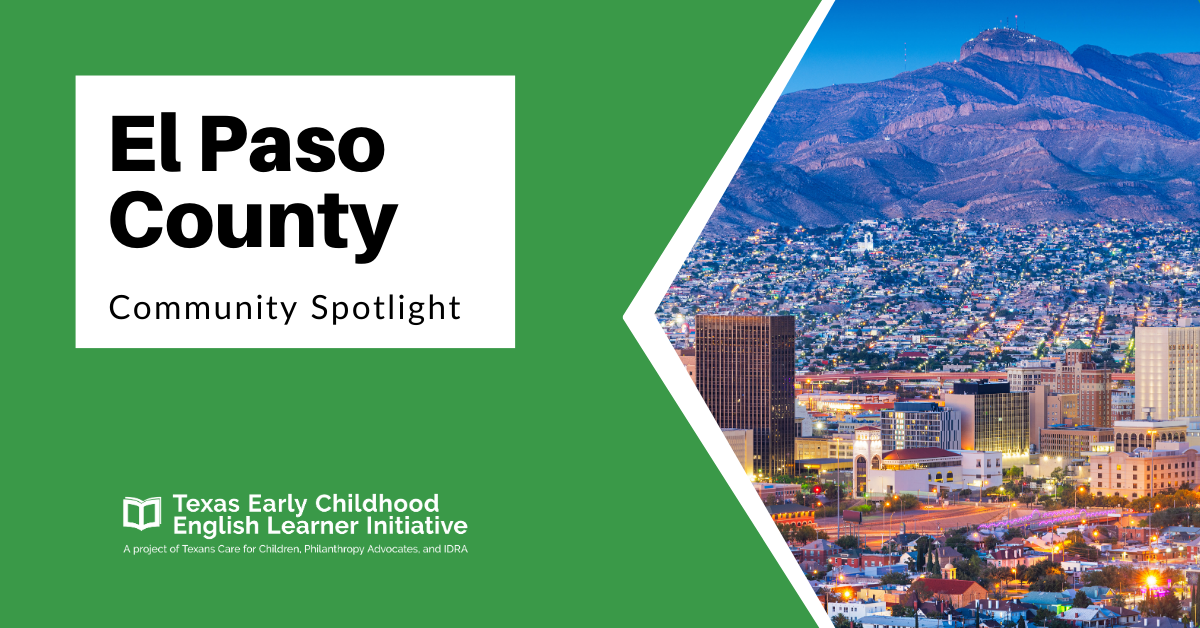Bexar County Spotlight
In 2015, Washington-based think tank New America wrote that “San Antonio, Texas is ahead of most other cities in designing and implementing reforms and strategies to support the academic and linguistic development of their dual language learners.” They cite significant investments in expanding access to high-quality pre-k, supporting English Learners’ (ELs) home languages by updating instructional models, and the development of robust family engagement programs that support ELs and their families.
In addition to describing the progress that’s been made in supporting ELs and their families, leaders in the community also point to challenges. They cite the educational and economic segregation that exists in San Antonio, and the difficult path still ahead in closing opportunity gaps. They also note that within the city of San Antonio, public education is spread across 17 different school districts, each with distinct approaches to early childhood and bilingual education.
In an effort to better collaborate on and advocate for early childhood education for the entire region, Early Matters San Antonio launched in 2019 to “bring together business, civic, education, philanthropic and nonprofit leaders to raise awareness about the link between investments in high quality early education and a strong economic future for San Antonio.” Through that work, the region is taking crucial steps to work more closely together to build a strong pipeline of educators, expand Dual Language Immersion (DLI) offerings, and promote high-quality early childhood education across the county. Early Matters San Antonio is also working to address the bilingual workforce specifically. Uniting school districts, the Pre-K 4 SA initiative described below, and local universities, they are working to become a leading region in the entire country to prepare and place highly skilled, bilingual teachers.
By the Numbers
-
Percent of Pre-k-3rd Grade Students designated as ELs:
Region 20: 18%
Northside ISD: 14%
San Antonio ISD: 23%
North East ISD: 19.0%
Statewide: 27%Limited English Speaking Households and Language:
Bexar County: 6.14%
Statewide: 7.44% -
ISD Bilingual/ESL Programs:
Northside ISD: Dual language two-way, Transitional early exit, ESL
San Antonio ISD: Dual language two-way, Transitional late exit, ESL
North East ISD: Dual language one-way and two-way, ESLAverage Pre-k Class Size:
Northside ISD: 18
San Antonio ISD: 21
North East ISD: 16Percent of 4-year olds in Full-day Pre-K*:
Northside ISD: 95.7%
San Antonio ISD: 0.20%
North East ISD: 100%
Statewide: 60%*HB 3 required districts offer full-day pre-k to eligible 4-year olds, with available waivers, beginning in the 19-20 school year
-
Provider breakdown:
TRS Providers: 111
Non-TRS Providers: 343
Providers: 454
Percent TRS: 24.4%Statewide:
TRS Providers: 2,059
Non-TRS PRoviders; 5,131
Percent TRS: 28.6%Average children per day:
TRS Average: 2,865
Non-TRS Average: 6,109
Combined Average: 8,974
Percent TRS: 31.9%Statewide:
TRS Average: 56,318
Non-TRS Average: 78,678
Percent TRS: 41.7%
Local Successes and Models
We took a closer look at three local programs to better understand how this community is addressing the education of English Learners during the first eight years of childhood and to identify potential examples for the rest of the state to consider. To accomplish that goal, we conducted a series of interviews with local leaders and gathered available regional data. We are grateful to leaders at East Central ISD, Pre-K 4 SA, and Texas A&M University- San Antonio for sharing their insights with us.
-
Officially opening its doors in 2013, Pre-K 4 SA represents a unique regional investment in high-quality early childhood education. Bringing together community leaders, Pre-K 4 SA has become a model for ensuring early education is high quality. Pre-K 4 SA operates its own high-quality pre-k programs, providing training and resources to thousands of teachers. It has also allocated $21 million in grants to improve early childhood educational quality and access throughout San Antonio by prioritizing regional collaboration to ensure all children have access to a high-quality early education. Pre-K 4 SA notes that evaluations of their programs show they are boosting 3rd grade reading and mathematics scores and high attendance.
Part of their approach also includes a significant focus on equipping their educators. Pre-K 4 SA works closely with their educators and families to ensure home languages are honored and celebrated in the classroom and that emergent bilingualism is treated as an asset to cultivate, not a deficit to overcome.
Pre-K 4 SA takes pride in its classroom placement strategies. They work closely and intentionally with families to ensure children are placed in a classroom that is able to build on their home language environment and support their bilingualism. In working with families, Pre-K 4 SA also works to identify what they refer to as “cultural liaisons” who can help provide a two-way communication to families, particularly those who might not speak English. The cultural liaisons, who are trusted members of the community, help share information about Pre-K 4 SA with families and bring back critical information regarding family needs.
-
East Central ISD (ECISD) is considered unique by its leadership for its geographic diversity, educating children from very urban, suburban, and rural communities. Long before it became a state priority, ECISD emphasized support for early childhood education and full-day pre-k. In addition to offering full-day pre-k for children who meet the state’s pre-k eligibility guidelines, as they have for many years, the district is now also offering full-day pre-k for all four-year olds. In 2018-19, the district maintained an average class size of 17 students in pre-k, better than the state’s recommended maximum of 22.
District leaders also emphasize they were among the first districts in the region to offer two-way Dual Language Immersion (DLI) within their early learning settings. Through two dual language academies, they offer DLI programming from pre-k through fifth grade. Among their numerous professional development focus areas for educators, the district has prioritized providing a strong foundation for Spanish grammar and how to teach it. In describing their DLI programs, district leaders note that children typically see an achievement uptick in elementary school but really shine in high school.
ECISD’s parent engagement strategies include a task force through which they invite community members and parents to discuss key updates in their educational programs. They also pride themselves on their annual multicultural celebrations that center on celebrating bilingualism.
-
Texas A&M-San Antonio leaders describe the University as having been established with a goal, in part, to ensure that “the Hispanic community South of Highway 90” had opportunities for a high-quality education. They underscore that the University is committed to addressing issues associated with language acquisition, multi-generational poverty, and educational attainment gaps. Over 70 percent of their students are Hispanic, and many are the first in their family to go to college.
The University is involved in the development of in-district charter schools in South San Antonio. Different from traditional charters, an in-district charter school is a partnership within a school district that allows a community partner to collaborate with the district and school board to operate schools under the district’s administration. University leaders hope to help develop schools across districts in the region to expand educational and workforce opportunities locally, from early childhood through 12th grade.
To support the districts with fewer resources, the University leverages these in-district charters to place bilingual educators in year-long, paid clinical experiences. They work with the educators to help pay for their Master’s Degree and provide extensive professional development and coaching, eventually becoming preferred hires for the district. This work, as they explain it, helps close the gaps between those districts that have the resources to provide these supports and those that don’t. As districts with fewer resources struggle to recruit and retain a quality bilingual certified workforce, this work is critical to place quality educators where they are needed most.
“Multiple languages are not to be feared. They're an asset in our classrooms. And if you're lucky enough to have multilingual children in your classroom, embrace it and make it to the benefit of everybody.”
— Sarah Baray, Pre-K 4SA



